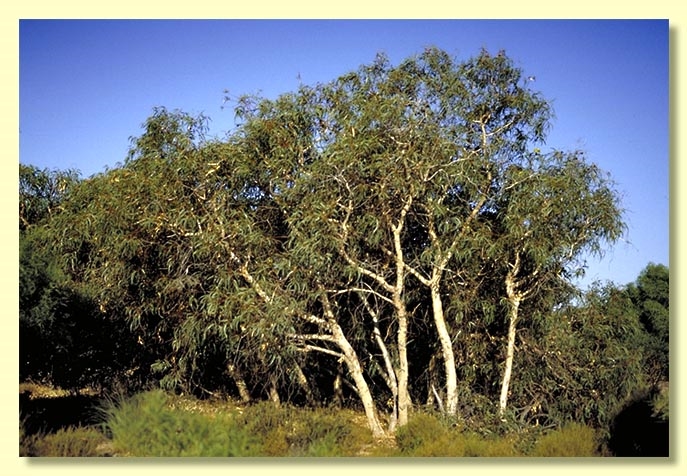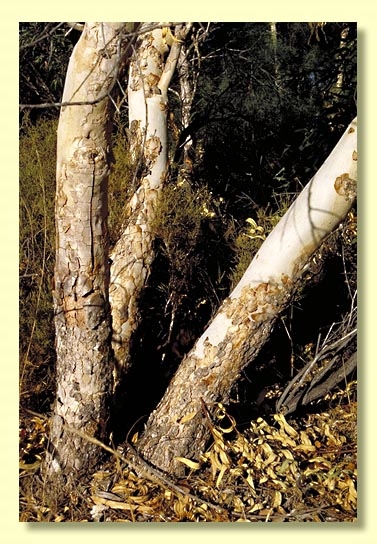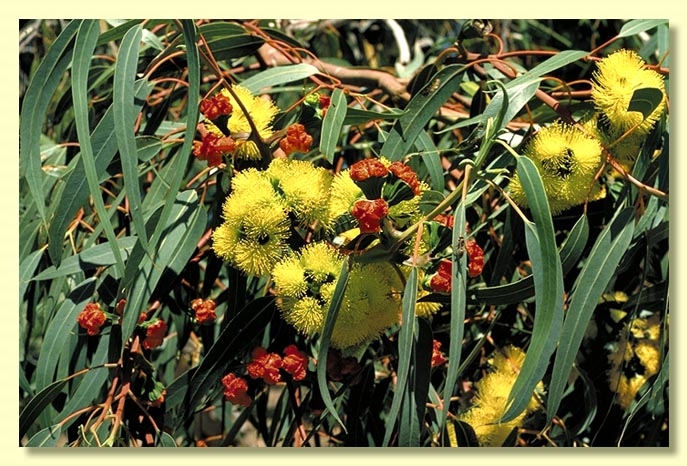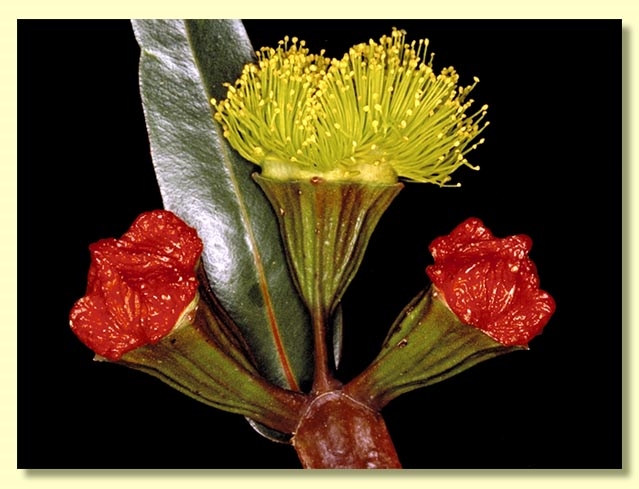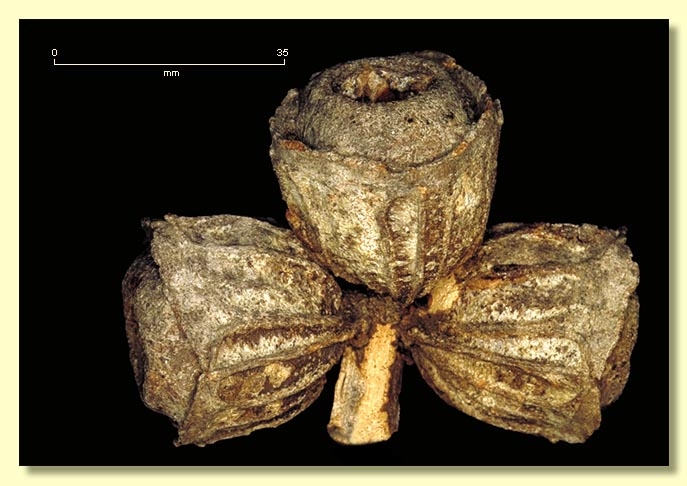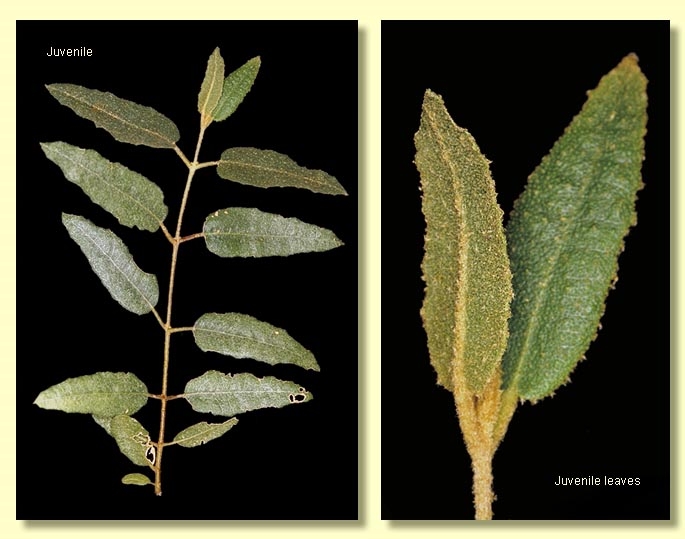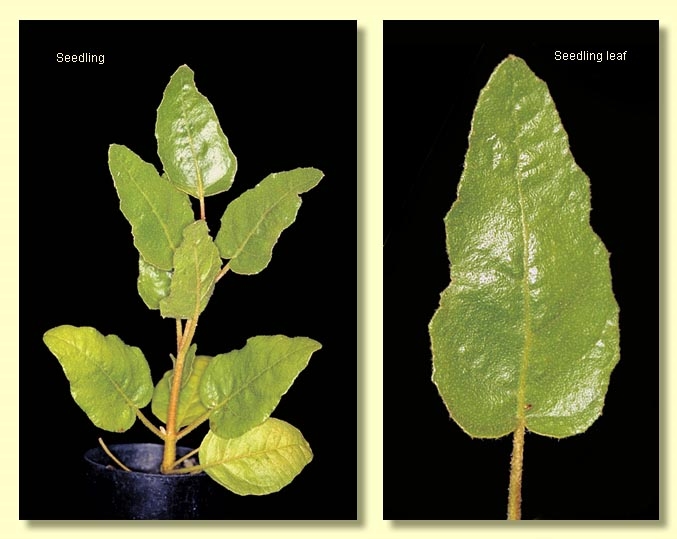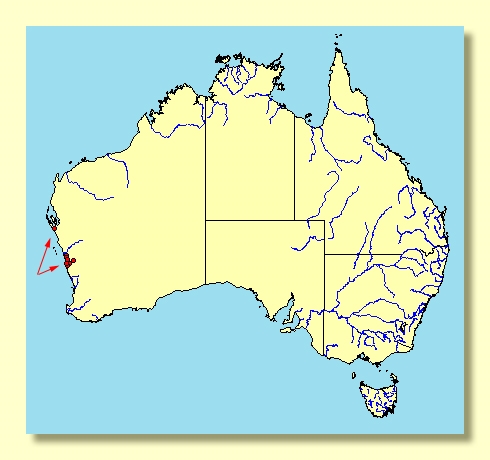Euclid - Online edition
Eucalyptus erythrocorys
Eucalyptus | Eudesmia | Limbatae | Heteropterae | Tetraedrae
Bark smooth, grey or grey-brown to cream or white, rarely developing a short stocking of loose thin brown box-bark on the lower trunk.
Branchlets not glaucous; oil glands present in the pith.
Juvenile growth (coppice or field seedlings to 50 cm): stems round in cross-section, not glaucous, hairy; juvenile leaves opposite, petiolate, lowest leaves deltoid, becoming broadly lanceolate to ovate to cordate, 5–13 cm long, (2)3–6 cm wide, base lobed to rounded to truncate, apex acute, green, hairy. Regrowth glabrous by 1 m tall.
Adult leaves opposite to sub-opposite, petioles 1.5–3 cm long; blade lanceolate to falcate, 9–20 cm long, 1.2–3 cm wide, base tapering to petiole, concolorous, glossy green, side-veins at an acute or wider angle to midrib, tertiary venation moderate, intramarginal vein present, oil glands mostly island.
Inflorescence axillary single, peduncles 1.2–2.6(3) cm long, buds 3 per umbel, pedicels 0.2–1 cm long. Mature buds obovoid, 2–2.5 cm long, 2–2.6 cm wide, hypanthium green, outer perianth whorl minutely sepaline, inner whorl operculate, operculum red, flattened with four lobes, stamens grouped in four clusters, inflexed, anthers oblong, versatile, dorsifixed, dehiscing by longitudinal slits (non-confluent), style long, stigma tapered, locules usually 3 or 4, the ovules arranged in 4 or 6 distinct vertical rows on the placentae. Flowers bright yellow to yellow-green.
Fruit pedicellate, rarely sessile (pedicels 0–1 cm long), broadly campanulate, four-lobed at the apex, 2.8–4 cm long, 3–5.5 cm wide, disc ascending, valves 3 or 4, enclosed.
Seeds dull brown to black, obliquely pyramidal, sides ribbed, 2–4 mm long, surface smooth not deeply pitted, hilum terminal.
Cultivated seedlings (measured at node 10): cotyledons reniform; stems round in cross-section, not glaucous, hairy, leaves petiolate, opposite, ovate to broadly lanceolate to cordate, 4.5–8 cm long, 2–4.2 cm wide, glossy green, margins irregularly toothed due to hairs, apex acute, base lobed to rounded to truncate, lamina hairy.
Flowering has been recorded in January, February, April and September.
Eucalyptus erythrocorys is a popular ornamental and is commonly used as a street tree, particularly in Perth but also in many South Australian and Western Australian country towns.
A small tree of subcoastal areas north of Perth, on undulating limestony sites from Cockleshell Gully to Dongara, with a further occurrence north of Kalbarri National Park where it grows as a mallee. The bark is smooth and the adult leaves are opposite, petiolate, falcate, glossy, dark green.
E. erythrocorys is one of the morphologically most remarkable species in the genus. It is easily recognised by the large buds in threes, the brilliant red operculum, the bright yellow flowers and the grossly sculptured fruits with massive undulating disc.
Eucalyptus erythrocorys belongs in Eucalyptus subgenus Eudesmia because of the combination of cotyledons reniform in shape and folded and clasping in embryo, buds with the calyx free and evident as four small teeth around the midline of the bud. (Sections Ebbanoenses and Reticulatae in this subgenus have the calyx fused to the corolla and evident as four small teeth at the apex of the bud.) Within subgenus Eudesmia, E. erythrocorys belongs in the Section Limbatae, series Heteropterae, subseries Tetraedrae, that is further characterised by having seedling leaves with stellate hairs, the presence of oil glands in the pith of the branchlets, stamens arranged in four bundles, flanged ± pyramidal seeds and buds and fruit square in cross-section. The other species in subseries Tetraedrae are E. gittinsii, E. pleurocarpa, E. extrica, E. eudesmioides, E. conveniens and E. roycei. E. erythrocorys, with its large red buds and bright yellow flowers and large sculptured fruit, should not be confused with any of these.
A very popular species in cultivation in warmer temperate areas where it forms a decorative small tree.

